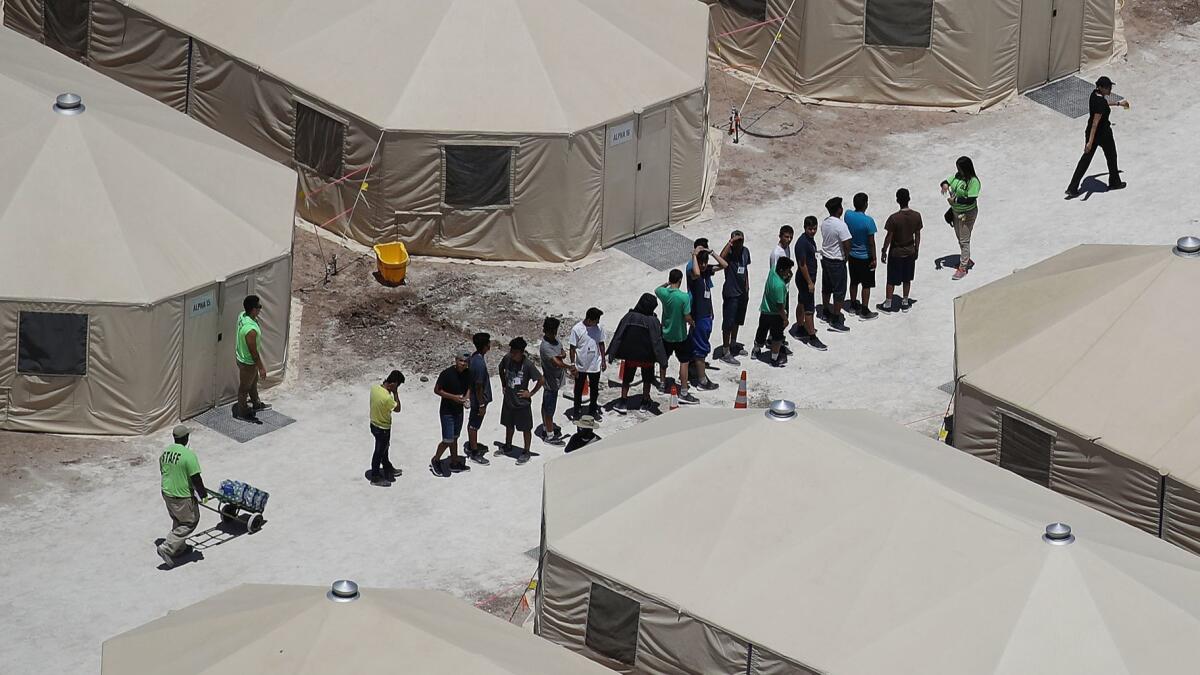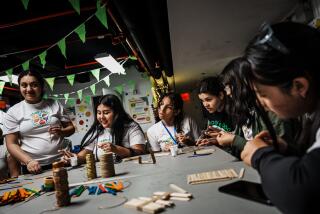Reporters tour tent city that’s housed thousands of migrant teens: ‘They treat us well, thank God’

- Share via
Reporting from Tornillo, Texas — A sign hung at the back of the sand-colored tent welcoming visitors: “Bienvenidos a Alpha 11.”
Ten tidy bunk beds filled the space, the name of each boy who occupied one written on blue tape affixed to the frame. On the way out hung two American flags and the house rules for the 1,500 children who call the Tornillo tent shelter home.
The temporary shelter for teenage boys and girls in the border town southeast of El Paso has drawn international attention and swidespread criticism since it opened in June, with many voicing concerns over the level of care.
Because it is considered temporary, it is not required to be licensed as a childcare facility or to provide the same medical, mental health and educational services as roughly 100 other facilities for immigrant children across the country.
On Friday, more than a dozen news reporters were allowed inside for a tour.
When the shelter opened, there were several hundred beds; it has since expanded to 3,800 beds, with many currently unfilled. The encampment has been run under short-term contracts by BCFS, a Texas-based nonprofit, and it expected to remain open at least through the end of the year.
An incident commander for BCFS led the tour and blamed delays in moving children to homes on a long wait for background check results.
In the Tornillo shelter there are currently 826 releases pending the results of noncriminal background checks of the sponsors, according to the incident commander, who asked not to be identified by name. He said that it is taking three plus months to get the check results back.
“I think it’s the right thing to do for these kids, but I think it should be done very quick,” he said. “I don’t understand why it’s taking so long.”
The average stay in all shelters for immigrant children is 59 days, according to the Department of Health and Human Services. Minors spend an average of 25 days at Tornillo, where they have been eventually taken, in most cases, because they arrived at the border themselves or with adults who were not their parents.
In the first 11 months of fiscal year 2018, 45,704 children were apprehended on the southern border, a 19% increase from the previous year, according to U.S. Customs and Border Protection.
Currently, there are 13,000 immigrant children living in government-contracted shelters, according to Mark Weber, a Health and Human Services spokesman. Sponsors are continuing to come forward, he said.
About 3,200 children have come through Tornillo since June, Weber said, with most of them transferred from another shelter.
“This is a last stop,” he said.
The number of those within the Tornillo shelter peaked on Sept. 28, at 1,637. The numbers have been going down, according to the incident commander.
In a telephone briefing with reporters earlier this month, Jennifer Podkul, policy director at the legal advocacy group Kids in Need of Defense, voiced concerns about the temporary shelter.
“There are obvious concerns about keeping kids in such a facility for long periods of time,” she said. “We’re worried that this is a trend to hold children in lower standards than what’s required by current law.”
Others have urged Congress to create an independent medical and mental health monitoring team for children in government custody.
A sample daily schedule for children in Tornillo includes social studies, math, English as a second language, science and an outside dorm activity.
Every unit is air conditioned, and in the boy’s section there are 20 in each tent. Three direct case workers are assigned to each unit, the incident commander said. In the Alpha 11 tent, boys decorated bunks with cutout pumpkins and spiders for Halloween. A printout of Jesus hung behind bunk 17.
All of those housed inside the shelter are aged 13 to 17. There have not been any attempted runaways, “which is highly unexpected,” the incident commander said.
Outside Barbershop 1, a line of boys from Honduras and Guatemala waited after getting their hair cut. Some have been in the shelter for 15 days.
“They treat us well, thank God,” one said.
Not too far off, dozens of boys raced down a turf field, playing soccer under a gray sky and in cool weather. The chain-link fence topped with barbed wire that surrounds the shelter is visible from the field.
“They’d rather play soccer than anything,” the incident commander said. He said the kids have been “well-behaved.”
The children are given private time with a lawyer, and the majority of them had received a legal screening before arriving, according to the incident commander. The children are watched 24/7, except when they are showering or in the bathroom.
There is also medical availability 24/7, with about 20 to 30 medical staff on one shift. There are four ambulances dedicated to the site, along with three fire trucks.
There are 32 direct-care clinicians, according to the mental health branch director. At least twice a day, clinicians will conduct wellness checks with each child.
Over the summer, the most common injuries were nosebleeds because of the dry air. The second most common were soccer injuries.
Boys and girls are kept separate, with about 300 girls housed in a large white ClearSpan structure. A pink teddy bear sat propped up on a pillow on one of the girl’s beds, and birthday balloons decorate others.
As reporters walked through the tent, a 15-year-old Guatemalan girl put away a kindergarten book for those aged 5 to 6. Many of the kids are at about a fourth-grade level, according to the incident commander.
A girl from El Salvador said that she’s been at the shelter for a month. She said she was treated well.
She gestured at the line of girls in front and behind her — they’re all her friends, she said.
In another part of the tent, dozens of girls sat at tables with composition notebooks, copying the words from a projected slide: “What is an equation?”
The smell of pork tamales and Spanish rice wafted over from a nearby table.
When asked about the decision to continue housing these kids, the incident commander questioned where they would end up otherwise.
“I had a choice. My choice was, do I let kids back up in a border facility? … That’s no place for a child,” the incident commander said. “What do I do with the children who are here? There’s no place for them to go.”
Times staff writer Molly Hennessy-Fiske contributed to this report.
Twitter: @Brittny_Mejia
More to Read
Sign up for Essential California
The most important California stories and recommendations in your inbox every morning.
You may occasionally receive promotional content from the Los Angeles Times.











